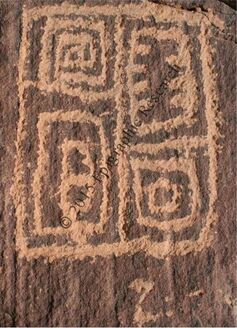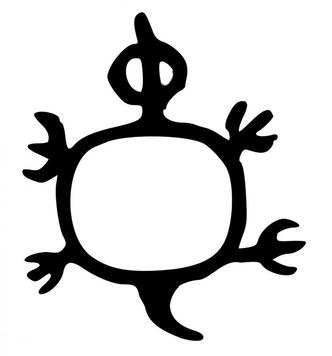Ongoing Supplemental Research
The following North American ancient Chinese script pictogram-glyphs have been statistically identified, based on an analysis of each symbol's pattern of line strokes, and subsequently evaluated for their readability by several independent and world-renowned experts on ancient Asiatic writing and by knowledgeable National Park Service personnel. These North American petroglyphs are without any doubt very old; and the style of the written symbols match with those of readable ancient Chinese scripts. Importantly, these symbols are not claimed by, or otherwise known to be associated with, any Native American tribe. Rather, they are readable ancient Chinese scripts that embodying a rhyming scheme which identifies them as an example of Chinese pianwen poetry used by the scholars of China's Bronze era. In the written opinion of the late Dr. David N. Keightley of UC-Berkeley these cartouches likely were created during the time of the Zhou dynasty in China.
Two readable side-by-side ancient numbered Chinese script cartouches located in Arizona
This combination of tightly grouped clusters of ancient Chinese scripts in Arizona is profoundly significant. In addition to the purposeful numbering of these clusters with ancient Chinese scripts to inform us of their reading order, the interiors of the cartouches are subdivided by one or more lines forming boxes into which the ancient author placed Chinese symbols in a meaningful and readable manner. This is clearly an example of ancient Chinese writing from pre-Columbian times pecked long ago into the rocks of North America.
Note: The significant level of repatination evident on these pictogram-glyphs is indicative of considerable age. Clearly, these images are not of recent manufacture. They are not modern fabrications (fakes), for knowledge of several of the ancient Chinese written symbols displayed here was lost to humanity shortly after the fall of China's Shang dynasty around 1040 BC. Only recently, in AD 1899, were these script forms rediscovered and subsequently deciphered from the 3000 year old oracle-bones unearthed in Anyang, China, and these images are demonstrably much older than a mere 117 years.
Note: The significant level of repatination evident on these pictogram-glyphs is indicative of considerable age. Clearly, these images are not of recent manufacture. They are not modern fabrications (fakes), for knowledge of several of the ancient Chinese written symbols displayed here was lost to humanity shortly after the fall of China's Shang dynasty around 1040 BC. Only recently, in AD 1899, were these script forms rediscovered and subsequently deciphered from the 3000 year old oracle-bones unearthed in Anyang, China, and these images are demonstrably much older than a mere 117 years.
The following are a few of the additional ancient Chinese script characters identified in this ongoing research endeavor.
|
|
|
Note: Comparative statistical analysis of the line strokes employed for writing each of the Chinese pictograms shown above, alongside their matching American petroglyphs, reveals that the likelihood for each of these petroglyphs to have been drawn separate from a knowledge of ancient Chinese, solely by chance, is in each instance less than one in a hundred (P < 0.01). Cumulatively, the combined probability for drawing all eight of these images apart from knowledge of ancient Chinese is less than one chance out of ten Quadrillion.
A fascinating desert tortoise
This pictogram-glyph is currently being evaluated, and the results of this analysis have not yet been published. Note the parallel use of a centerline in each drawing. Curiously, the association of tortoise images with a specific compass direction, especially North, is an ancient practice widely employed by Asiatic populations and also by some Native Americans.
Three readable ancient Chinese scripts near Las Vegas, Nevada
Photo of the Albuquerque pictogram-glyphs
|
About the Images
Copyrighted works appear on this website. All use of such names or works is for educational purposes only and solely to the benefit of the trademark or copyright owner, with no intention of infringing upon that trademark or copyright. The entire contents of this website are Copyright 2016 Epigraphic Research, All Rights Reserved, unless otherwise noted. Images and photographs appearing on this website are © 2010 - 2021 Epigraphic Research, unless otherwise noted. Access to this site does not grant any rights to copy, publish, sell, license, distribute or use any included materials, including photographs, text, backgrounds or design elements in any form or media, without the expressed and written permission of the copyright holder. Please use the Contact Us link to the left if you would like to use any of the website imagery or text. |
Contact us today!
Epigraphic Research welcomes your questions and queries. Please use our "Contact Us" page to send us your questions and comments. |










